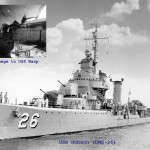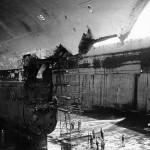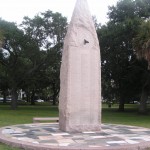As a veteran of Naval Aviation, I have witnessed first-hand the dangers of aircraft carrier operations. While flight operations are being conducted, the activities above and below decks on a carrier must be meticulously coordinated. Mistakes all too often lead to serious accidents.
This careful coordination of activities extends beyond the aircraft carrier itself, to the support ships that escort the carrier. When viewed from an aircraft above, these support ships constantly engage in a precise ballet to remain in the proper position closely aft and to the side of the carrier to support flight launch and recovery operations. This is not an easy task. The carrier is always ‘chasing the wind’ – constantly changing heading and speed to keep sufficient wind flowing directly down the deck. The support ships are tasked with keeping proper position in relation to the carrier, often at night or in bad weather and heavy seas.
The U.S.S. Hobson (DD-464) , a Gleaves-class destroyer was built at the Charleston Navy Yard and commissioned shortly after the outbreak of WWII. During the war she saw action in North Africa, the western Atlantic, and at D-Day. Late in 1944 she was converted to a destroyer-minesweeper and reclassified DMS-26. After this conversion she saw heavy action near Okinawa, where she suffered significant casualties and damage from enemy suicide attacks. Repairs were completed after WWII and the Hobson took up duty as a destroyer-minesweeper with the Atlantic Fleet.
On the night of April 26, 1952 the Hobson was a support ship for the aircraft carrier U.S.S. Wasp (CV-18), which was conducting flight operations 700 miles west of the Azores. The Wasp began a turn into the wind to prepare for aircraft recovery. The Hobson needed to maneuver to maintain its correct position in reference to the Wasp. A tragic miscalculation took place on the Hobson bridge that night. The Hobson turned port in a maneuver that required crossing the bow of the Wasp, instead of simply falling behind the Wasp and turning in the carrier’s wake. The Hobson was struck amidships by the Wasp. The collision cut the Hobson in half. She sank in less than five minutes. 176 of her crew were lost at sea, many asleep in their berthing compartments.
I have read several accounts of the events on the bridge of the Hobson that night – the best being found in Kit Bonner’s book, Final Voyages. An official Navy inquiry laid blame on the Commanding Officer of the Hobson, Lieutenant Commander W.J. Tierney, who died in the accident. Suffice it to say that procedures broke down that night – and that 176 men paid the ultimate price for a mistake in judgement.
Governments and their military seldom build memorials to those lost in accidents – they don’t wish to draw attention to such incidents. Within the beautiful Battery area of Charleston, South Carolina, however, stands a monument to those lost in the Hobson accident. It was built and paid for by the “U.S.S. Hobson Memorial Society” – a group of former shipmates, families and friends of the lost men of the Hobson. One side of the monument briefly describes the events of April 26, 1952. The other side lists the names of the lost, and the time and date of the accident. The monument is simple as an art piece, but I find my eyes are drawn to the platform – constructed of stones collected from the 38 home states of those lost at sea in just four minutes. These stones, perhaps more than anything else about the memorial, create a visual image in color and number of the scope of the loss of life that April night. Viewed from above one can almost visualize a small ship breaking apart on a big ocean, lives from numerous states scattered on the Atlantic floor, like the stones of the platform – a boy from Ohio lies here, another from Texas lies there, and one from California there, and on and on…
Damage to the Wasp showing the violence of the collision. The Wasp lost almost 90 feet of her bow.
Jim Teresco’s fine photographs of the
U.S.S Hobson Memorial
Additional information on the history of the U.S.S. Hobson can be found at the following links:
http://en.wikipedia.org/wiki/USS_Hobson_(DD-464)
http://www.cv18.com/hist/hobson.html




Eddie Young said:
My wife’s uncle served aboard USS Hobson when she was lost. Before he left for that deployment, he told his mother that he did not trust the captain of the ship. I read the article about the 16″ turret explosion aboard USS Iowa and it mentioned Hobson and her loss. From that I was able to tell my mother-in-law about the loss and the ship’s information. She didn’t know the name of the ship. I don’t think that they talked too much about in her home, like others. She was very thankful just to know what I had found. Though I am not related by blood her family had two Tin Can sailors in her family and for that I am also thankful.
Joseph Tetley said:
My mothers first husband was on the Hobson when the accident happened. How would I find out if his body was recivered or not. His name was David A. Turner.